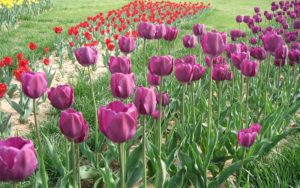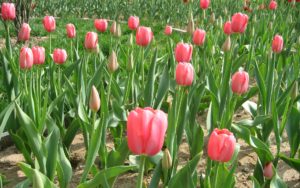Introduction of Tulip cultivation: – Tulips are very famous ornamental bulbous flowers grown due to their attractiveness. There are many improved varieties (cultivars) developed in this bulb growing industry. Tulip cultivation is limited in India. However, Himachal Pradesh and hilly areas of Jammu and Kashmir are perfect for Tulip cultivation. Most tulips thrive in colder winters because of the long chilling requirement for bulbs. Tulips can be grown in pots, containers, prepared beds, borders, basins of other orchards like apples, cherry, etc. Tulips can be grown in green house, poly house and shade net as well. Tulip plant belongs to the family of “Liliaceous” and genus of “Tulip L”.
Actually, Tulips are spring blooming perennials that grow from bulbs. Depending on the species (Variety), tulip plants can be between 10cm and 70cm high. When it comes to flower, it is usually shaped like a cup or egg with 6 petals. The tulip flower petals are available from single color to multi-colors with different patterns depending on the variety or species. The tulip flowers come in many colors like orange, pink, cherry, magenta, salmon, red, scarlet, chocolate, brown along with many shades. Tulip is the most popular garden flower due to its appearance and is used in decoration of various parties.
 Varieties of Tulips: – There are many improved cultivars (varieties) grown throughout the world. However, there are three classes of tulips; early flowering Tulip, mid season Tulips, late flowering Tulips. In India, The main varieties of early flowering Tulips are; Single Early, Due van Toll and mid season Tulips are; Triumph, Mendel. The late season Tulip varieties are Breeder, Lily flowered, Rembrandt, Bijbloemen, Double late, Parrots, Darwin, and Darwin hybrids. Tulip satellite and taitchisonii are grown in Himalaya regions.
Varieties of Tulips: – There are many improved cultivars (varieties) grown throughout the world. However, there are three classes of tulips; early flowering Tulip, mid season Tulips, late flowering Tulips. In India, The main varieties of early flowering Tulips are; Single Early, Due van Toll and mid season Tulips are; Triumph, Mendel. The late season Tulip varieties are Breeder, Lily flowered, Rembrandt, Bijbloemen, Double late, Parrots, Darwin, and Darwin hybrids. Tulip satellite and taitchisonii are grown in Himalaya regions.
Climate required for Tulip cultivation: – Tulip can be grown in full sun or partial shade. However, Tulip grown in hills requires a day temperature of 20-26ᵒC and night temperature of 5-12ᵒ C during growth period. Direct sun during morning and evening is beneficial for improving its flower quality, whereas partial shade is required during mid-day (12 to 4 PM). Tulips are very sensitive to frost. The best natural suitable areas in India are Shimla, Kangra, Kullu, Solan, Sirmour, and Mandi. It is little tricky to grow Tulips in hot climates. However, one can go for protected controlled environment like green house and poly house for growing Tulip flowers.
Soil requirement for Tulip cultivation: – Generally, Tulip bulbs are grown on slopes where drainage is naturally good. Therefore, Tulips require well-drained light sandy loam soils for better growth and yield. If you are not sure about soil drainage, planting these tulip bulbs on raised beds are recommended. In case of heavy soils, adding well decomposed compost or peat moss or other organic matter helps in crop growth. If tulips are grown on commercial scale, make sure to test the soil for fertility. The soil ph of 6.0 to 7.0 is ideal for Tulip cultivation. Avoid heavy clay soils and poor soils.
Land preparation for Tulip cultivation: – Land should be prepared by getting the soil to fine tilth stage and removing and weeds from previous crops. Soil should be supplemented with appropriate garden compost or organic manure. In case of poor drainage, it is better to prepare raised beds.
Propagation, planting and Spacing in Tulip Cultivation: – Tulips are propagated by bulb lets and bulbs. They can also be propagated by seeds. However, it produces different shades of flowers. October to December is ideal time for planting in mid hills at 1100 to 1800 meter mean sea level (m.s.l) and November to December and February months are ideal for high hill regions which are above 1800 meter mean sea level (m.s.l). The staggered planting at 2 weeks intervals ensure regular cut flower supply. The depth of the planting will depend upon the size of the bulb. In general, tulip bulbs should be planted 5 to 8 cm deep at spacing of 15cm X 10cm. Plant 3 to 5 bulbs in 15cm pot, if they are intended to grow in pots. Partial shading during mid day (12am to 4pm) is beneficial for flower longevity. To get a good crop of flower, bulbs of 10-12cm size or more should be selected as planting material.
Irrigation in Tulip cultivation: – Irrigation depends on soil type, climate. However alternate day irrigation should be carried out in case of green house and poly house cultivation. In case of open areas, irrigation should be given at weekly case of heavy water, make sure the water in areas where water is major problem. In case of heavy water, make sure the water is drained from the field otherwise plant rot occurs. Enough soil moisture should be maintained throughout its growth period for better quality of flowers and yield.
Weed management in tulip cultivation: – Keeping the field weed free is very important for healthy tulip plantation. Manual weeding and any suitable Weedicides can be used to control the weed growth. Mulch the tulip plants to protect from moisture loss and to control the weeds.
Manures and Fertilizer in Tulip cultivation: – Dry cow manure and compost are excellent organic manures for tulip cultivation. Well rotten farmyard manure (FMY) @ 3-5 kg/m2 should be mixed thoroughly. Spraying of micronutrient rich solution Multiplex @ 50ppm (once or twice) before color breaking is beneficial in Tulip cultivation. The best inorganic fertilizer is a general purpose one such as NPK5-10-5, with 5% nitrogen (N), 10% phosphorus (P) and 5% potassium (K).
Pests and diseases in Tulip cultivation: – Tulip flowers are attacked by trips. Spraying of Rogor (0.05%) controls them effectively. Bulb rot is controlled by treating them with Bavistin (0.1%) or Dithane M-45 (0.2%). Tulip crop is also infested with aphids. Application of recommended doses of Endosulfan, Malathion, Aldicarbs is beneficial to control this pest. Fusarium infection causes a ‘sour’ smell from the bulbs and the appearance of a white mould on tunic. Removal of tunic reveals soft infected bulbs. The bulbs, badly damaged by the fungus, become hollow and light in weight. Soil drenching with 0.2% Benomyl is recommended to control this disease.
Note: – Contact your local floriculture department for pests and disease found in tulip cultivation. They are the best source for disease control solution.
Harvest in Tulip cultivation: – When it comes to cut flower harvesting, usually tulips start flowering Feb-April in mid hills and April-June in High hill regions. The scopes along with two leaves should be cut when 25%-50% color develops on flower petals.
When it comes to bulb harvesting, they should be harvested when tulip plant leaves start leaving yellow or 45 days after flowering. Remove old bulb scales and roots. These bulbs should be air dried in shade tulip bulbs should be stored at 7-10ᵒ C for 7-8 weeks during Sep-Oct for proper development of flower primordial. Make sure that these flower bulbs are not stored in damp or moist conditions.
